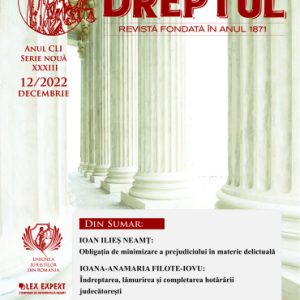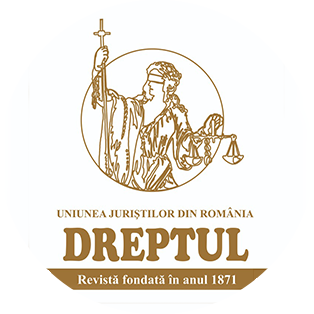-
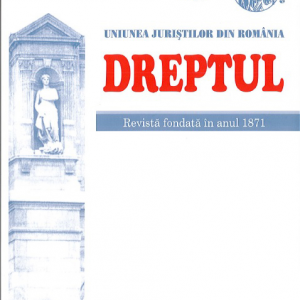 This study presents the divergent case law generated by the current insufficient regulation of the legal regime of burial plots and funeral constructions, such as burial vaults and crypts. While some courts admit the assignment of the tomb to one heir, others consider that the concession right over the burial plot and the funeral constructions bears upon a forced and perpetual indivisibility which excludes the division. As a solution, it proposes a clarification of the legal regime applicable to funeral concessions and the explicit regulation of the use of underground burial vaults, especially from the perspective of the exclusive right to be buried in a particular crypt.
This study presents the divergent case law generated by the current insufficient regulation of the legal regime of burial plots and funeral constructions, such as burial vaults and crypts. While some courts admit the assignment of the tomb to one heir, others consider that the concession right over the burial plot and the funeral constructions bears upon a forced and perpetual indivisibility which excludes the division. As a solution, it proposes a clarification of the legal regime applicable to funeral concessions and the explicit regulation of the use of underground burial vaults, especially from the perspective of the exclusive right to be buried in a particular crypt. -
 The stages of the civil trial are: (i) the stage of referral to the court of law (written or initiating the civil trial), (ii) the stage of inquiry of the trial, (iii) the stage of debate on the merits of the trial, (iv) the stage of deliberation and (v) the stage of delivery. The accomplishment of the act of justice in civil matters is materialized through court sittings (which may be public, or in which only the parties participate, or not public, in the cases provided by law) and internal administrative stages carried out by the panel of judges (such as the checking and regularisation of the application). Publicity is a fundamental principle of the civil trial stated by the provisions of Article 17 of the Civil Procedure Code and by Article 12 of the Law No 304/2004, republished. The failure to ensure the publicity of the court sitting brings about the sanction of absolute nullity not conditioned by the existence of an injury under Article 174 (2) by reference to Article 176 point 5 of the Civil Procedure Code. The delivery of the judgment shall usually take place in public sitting, according to Article 402 of the Civil Procedure Code, or, as an exception, by making the solution available to the parties through the mediation of the registry office, pursuant to Article 396 (2) of the same Code, in the assumption that the delivery was postponed (premise condition) for justified reasons and the chairman of the panel has indicated expressis verbis this modality of putting the solution at the disposal of the parties. The delivery of the judgment, as the last processual stage, according to the Civil Procedure Code, can not take place otherwise than by means of a public court sitting, according to the principle of publicity, to which the chairman or a member of the panel of judges read the minutes, also indicating the means of appeal which can be exercised. The fact that the parties understand or not to make use of their right to appear in court (as in the case of other processual stages) does not in any way affect the obligation of the panel of judges to comply with the express provisions of the law in respect of the processual stage of delivery, since there is no such distinction in the law, and ubi lex non distinguit nec non distinguere debemus. In addition, the completion of this final stage of the civil trial is necessary for the parties to make use of their right to formulate orally the means of appeal provided by law, according to Article 126 of the Internal rules of the courts of law of 2015, concluding in this respect a minutes signed by the president of the panel and by the registrar of the sitting.
The stages of the civil trial are: (i) the stage of referral to the court of law (written or initiating the civil trial), (ii) the stage of inquiry of the trial, (iii) the stage of debate on the merits of the trial, (iv) the stage of deliberation and (v) the stage of delivery. The accomplishment of the act of justice in civil matters is materialized through court sittings (which may be public, or in which only the parties participate, or not public, in the cases provided by law) and internal administrative stages carried out by the panel of judges (such as the checking and regularisation of the application). Publicity is a fundamental principle of the civil trial stated by the provisions of Article 17 of the Civil Procedure Code and by Article 12 of the Law No 304/2004, republished. The failure to ensure the publicity of the court sitting brings about the sanction of absolute nullity not conditioned by the existence of an injury under Article 174 (2) by reference to Article 176 point 5 of the Civil Procedure Code. The delivery of the judgment shall usually take place in public sitting, according to Article 402 of the Civil Procedure Code, or, as an exception, by making the solution available to the parties through the mediation of the registry office, pursuant to Article 396 (2) of the same Code, in the assumption that the delivery was postponed (premise condition) for justified reasons and the chairman of the panel has indicated expressis verbis this modality of putting the solution at the disposal of the parties. The delivery of the judgment, as the last processual stage, according to the Civil Procedure Code, can not take place otherwise than by means of a public court sitting, according to the principle of publicity, to which the chairman or a member of the panel of judges read the minutes, also indicating the means of appeal which can be exercised. The fact that the parties understand or not to make use of their right to appear in court (as in the case of other processual stages) does not in any way affect the obligation of the panel of judges to comply with the express provisions of the law in respect of the processual stage of delivery, since there is no such distinction in the law, and ubi lex non distinguit nec non distinguere debemus. In addition, the completion of this final stage of the civil trial is necessary for the parties to make use of their right to formulate orally the means of appeal provided by law, according to Article 126 of the Internal rules of the courts of law of 2015, concluding in this respect a minutes signed by the president of the panel and by the registrar of the sitting. -
 The provisions of Article 169 of the Law No 85/2014 on the procedures for preventing insolvency and for insolvency regulate the responsibility aimed at covering the debtor’s liabilities in case its assets do not satisfy all the claims of its debtors. The mentioned legal provisions regulate expressly determined cases in which either the members of the supervisory bodies, or the members of the management bodies of the legal person which is in a state of insolvency or any other person that has caused the state of insolvency may be obliged to cover a part of the liabilities of the insolvent debtor, provided that the activity they carried out has led to the insufficiency of the available cash funds from the patrimony of the debtor legal person. In relation to the provisions of Article 171 of the mentioned normative act, the responsibility of the specified persons may be engaged in any form of the procedure, either in judicial reorganization, or in bankruptcy. In case of judicial reorganization, the amounts of money obtained as a result of the responsibility of the mentioned persons are intended to supplement the funds necessary for the continuation of the debtor’s activity, and, in case of bankruptcy, those amounts must ensure that the debtor’s liabilities are covered. The regulation of the responsibility of the members of the supervisory/management bodies or of any other person that has caused the state of insolvency of the debtor legal person is an integral part of the procedure provided by the law on insolvency.
The provisions of Article 169 of the Law No 85/2014 on the procedures for preventing insolvency and for insolvency regulate the responsibility aimed at covering the debtor’s liabilities in case its assets do not satisfy all the claims of its debtors. The mentioned legal provisions regulate expressly determined cases in which either the members of the supervisory bodies, or the members of the management bodies of the legal person which is in a state of insolvency or any other person that has caused the state of insolvency may be obliged to cover a part of the liabilities of the insolvent debtor, provided that the activity they carried out has led to the insufficiency of the available cash funds from the patrimony of the debtor legal person. In relation to the provisions of Article 171 of the mentioned normative act, the responsibility of the specified persons may be engaged in any form of the procedure, either in judicial reorganization, or in bankruptcy. In case of judicial reorganization, the amounts of money obtained as a result of the responsibility of the mentioned persons are intended to supplement the funds necessary for the continuation of the debtor’s activity, and, in case of bankruptcy, those amounts must ensure that the debtor’s liabilities are covered. The regulation of the responsibility of the members of the supervisory/management bodies or of any other person that has caused the state of insolvency of the debtor legal person is an integral part of the procedure provided by the law on insolvency. -
 Cloud Computing is one of the most innovative technologies in the history of computing. It is radically changing the way how information technology services are created, delivered, accessed and managed. Cloud Computing enables the same services and user content to be delivered to any user device, whether a mobile phone, desktop or tablet computer. Cloud technology involves data storage at multiple data centers in different geographic locations. The evolution of computer technology is strongly related with the cybercrime phenomenon. Over the last decade, the number of crimes that involve computers and Internet has grown constantly. Criminal organizations try to be as efficient as possible and in order to make investigations difficult they are storing criminal data in foreign servers or in Cloud storage systems, and use cryptography and other data obfuscation techniques that hide their illicit activity. Cloud Computing offers criminals accessible means for committing cybercrime. In much the same way as cybercrime may be understood as a new way of committing traditional crimes such as fraud and theft, Cloud Computing presents criminals with new tools with which to commit these offences and many more. Researching this environment is a key element in understanding the new and more complex forms of cybercrime that occur today.
Cloud Computing is one of the most innovative technologies in the history of computing. It is radically changing the way how information technology services are created, delivered, accessed and managed. Cloud Computing enables the same services and user content to be delivered to any user device, whether a mobile phone, desktop or tablet computer. Cloud technology involves data storage at multiple data centers in different geographic locations. The evolution of computer technology is strongly related with the cybercrime phenomenon. Over the last decade, the number of crimes that involve computers and Internet has grown constantly. Criminal organizations try to be as efficient as possible and in order to make investigations difficult they are storing criminal data in foreign servers or in Cloud storage systems, and use cryptography and other data obfuscation techniques that hide their illicit activity. Cloud Computing offers criminals accessible means for committing cybercrime. In much the same way as cybercrime may be understood as a new way of committing traditional crimes such as fraud and theft, Cloud Computing presents criminals with new tools with which to commit these offences and many more. Researching this environment is a key element in understanding the new and more complex forms of cybercrime that occur today. -
 Unpaid community work has received multiple valences in the Romanian criminal law system, representing either an obligation in the content of the probation measures or a way of executing the penalty of the fine or an obligation that accompanies the abandonment of the criminal prosecution. The complexity of the institution, together with its novelty, has generated a series of difficulties including in respect of the performance of the unpaid community work, this article emphasizing some of these difficulties and proposing solutions for their removal.
Unpaid community work has received multiple valences in the Romanian criminal law system, representing either an obligation in the content of the probation measures or a way of executing the penalty of the fine or an obligation that accompanies the abandonment of the criminal prosecution. The complexity of the institution, together with its novelty, has generated a series of difficulties including in respect of the performance of the unpaid community work, this article emphasizing some of these difficulties and proposing solutions for their removal. -
 The relation between the civil servant and the public authority or institution in which he occupies the public office arises and is exercised on the basis of the unilateral administrative act of appointment, issued according to the legal provisions, and not by a contractual act. That is why the public function and the status of the civil servant have been regulated in the public law, separately from the labour relations specific to the private law, at the same time also determining the establishment of a specific sanctioning system, which takes into account the distinctive features of the way in which the public office is exercised. In this study there are analysed, from a dual perspective, theoretical and practical, the conditions of each form of the legal liability governed by the administrative law. At the same time, we also consider the cumulation of the disciplinary liability with other forms of legal liability of the civil servant for the damaging consequences of his deeds. A few aspects of novelty brought by the codification of the legislation on the liability of the civil servants in the Draft Administrative Code complete our research.
The relation between the civil servant and the public authority or institution in which he occupies the public office arises and is exercised on the basis of the unilateral administrative act of appointment, issued according to the legal provisions, and not by a contractual act. That is why the public function and the status of the civil servant have been regulated in the public law, separately from the labour relations specific to the private law, at the same time also determining the establishment of a specific sanctioning system, which takes into account the distinctive features of the way in which the public office is exercised. In this study there are analysed, from a dual perspective, theoretical and practical, the conditions of each form of the legal liability governed by the administrative law. At the same time, we also consider the cumulation of the disciplinary liability with other forms of legal liability of the civil servant for the damaging consequences of his deeds. A few aspects of novelty brought by the codification of the legislation on the liability of the civil servants in the Draft Administrative Code complete our research. -
 The content of the medical legal relation includes all rights and obligations of the provider and of the beneficiary of the medical service. Among these, only the rights of the patient benefit by an explicit and ample special regulation and by a growing doctrinal interest. However, this does not mean the lack of specific rights in favour of the doctor, but only the necessity to identify the existence and the determination of their content by analyzing the nature and/or the implicit effects of the legal provisions and of the jurisprudential solutions. Thus, the patient’s acceptance by the doctor, based on Article 663 (1) of the Law No 95/2006, is the equivalent of the informed consent of the patient, expressed pursuant to Articles 660–662 of the Law No 95/2006 and Articles 13–20 of the Law No 46/2003; the interruption of the relation between the doctor and the patient, pursuant to Article 664 (1) c) (ii) of the Law No 95/2006, as a result of a hostile and/or irreverent attitude towards the doctor, would be impossible in the absence of an obligation of gratitude of the patient, correlative to a right to gratitude of the doctor; and the jurisprudential consecration of the liability of the sanitary unit for the damage suffered by the doctor due to a nosocomial infection is due precisely to the existence of a right to security of the doctor.
The content of the medical legal relation includes all rights and obligations of the provider and of the beneficiary of the medical service. Among these, only the rights of the patient benefit by an explicit and ample special regulation and by a growing doctrinal interest. However, this does not mean the lack of specific rights in favour of the doctor, but only the necessity to identify the existence and the determination of their content by analyzing the nature and/or the implicit effects of the legal provisions and of the jurisprudential solutions. Thus, the patient’s acceptance by the doctor, based on Article 663 (1) of the Law No 95/2006, is the equivalent of the informed consent of the patient, expressed pursuant to Articles 660–662 of the Law No 95/2006 and Articles 13–20 of the Law No 46/2003; the interruption of the relation between the doctor and the patient, pursuant to Article 664 (1) c) (ii) of the Law No 95/2006, as a result of a hostile and/or irreverent attitude towards the doctor, would be impossible in the absence of an obligation of gratitude of the patient, correlative to a right to gratitude of the doctor; and the jurisprudential consecration of the liability of the sanitary unit for the damage suffered by the doctor due to a nosocomial infection is due precisely to the existence of a right to security of the doctor. -
 The study discusses a very delicate matter, marked by many controversies and tensions – namely the matter of ensuring the right to consult the file in the criminal prosecution phase. Within this study it is recognized the importance of exercising this right, as a component of the right to defence and as a guarantee of the right to a fair trial, but there are also provided relevant arguments as to how the access of the defence to the file can disrupt the proper conduct of the judicial activity. There are also analysed possible deeds with criminal significance if certain aspects revealed within this procedure are brought to the knowledge of the persons who do not have this right.
The study discusses a very delicate matter, marked by many controversies and tensions – namely the matter of ensuring the right to consult the file in the criminal prosecution phase. Within this study it is recognized the importance of exercising this right, as a component of the right to defence and as a guarantee of the right to a fair trial, but there are also provided relevant arguments as to how the access of the defence to the file can disrupt the proper conduct of the judicial activity. There are also analysed possible deeds with criminal significance if certain aspects revealed within this procedure are brought to the knowledge of the persons who do not have this right. -
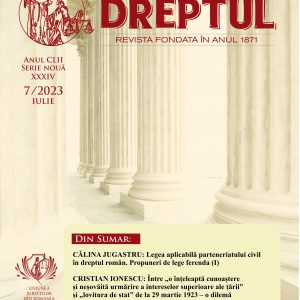
-
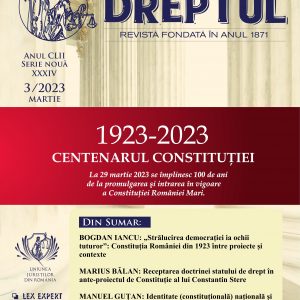
-
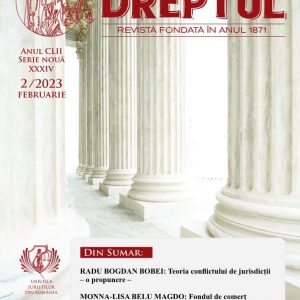
-
